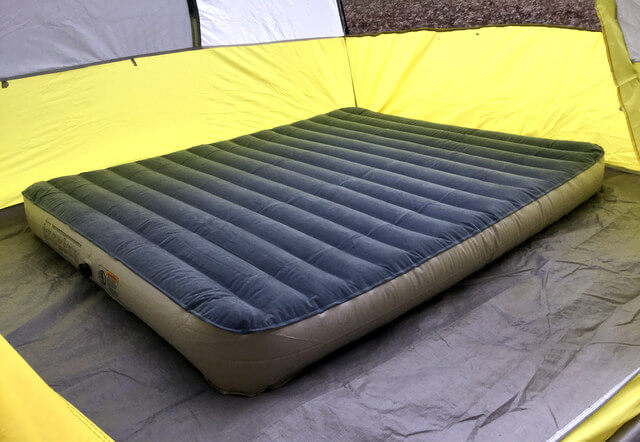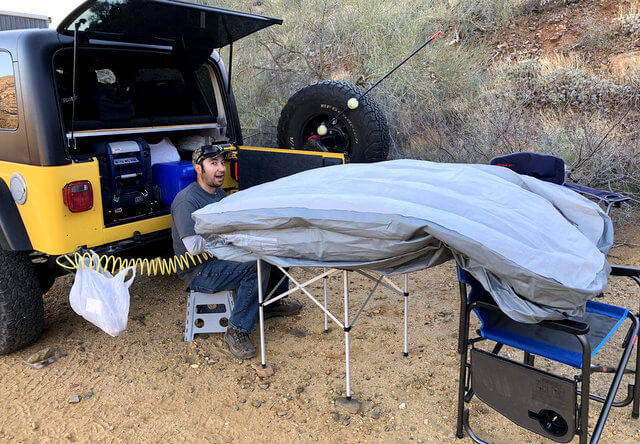Camping can mean an incredible adventure, but the one thing that can easily ruin your experience is a bad camping mattress. Not only does a bad mattress have the potential to compromise your health, it’s usually even worse than if you were to just sleep on the ground!
There are many things you’ll need to consider when buying a quality camping mattress, but the biggest thing to remember is that not one size fits all; you should be buying a mattress that’s suitable for you.
From the size to the practicality of traveling with it, the following are essential factors to consider when buying a camping mattress.
Things to Consider When Buying a Camping Mattress
Look for Your Desired Size
You might be tempted to buy the first camping mattress you find on ebay, but size really matters, and can make a huge difference to your sleep quality.
What is your body size and how tall are you? Your height and size will, of course, determine the size of the camping mattress to go for.
Buying a mattress without considering your size means you may end up with body parts hanging off it throughout the night. And you’re not going to be comfortable if it’s too small or slim for you.
It’s really important to take care of your spine when choosing a mattress. We recommend testing out your camping mattress before you head out to ensure that it fits your body size.
Construction & Ability To Pack
How will you travel to your camping site? Do you own a car, or you will have to carry your camping mattress on your back?
These are crucial questions you need to ask yourself. For instance, if you’re packing everything in the car and can drive right up to the campsite, the weight of the camping mattress won’t be an issue. You can pack the heaviest mattress you can find and won’t have to carry it!
But, if your campsite requires a bit of a hike, a light camping mattress is more appropriate, and your back will thank you for it later. Most trekkers choose to camp on a thin foam mattress as these are the lightest and most portable to attach to a backpack.
The construction of the mattress also matters in this regard. You’ll need to consider portability, especially if you’re hiking and have to carry it. Only go for the one whose construction is convenient for your purposes.
Image: The Greater Southwestern Exploration Company (CC BY 2.0) via Flickr
R-Value
“R” stands for resistant. Resistance in this case means against the cold air and ground, and this is a factor that you cannot ignore.
Being that you’ll be spending your nights in the cold as well as on the ground, even the thinnest foam mattresses act to provide a layer between you and the cold ground. This protects your body from being in direct contact with the cold ground.
If you are particularly susceptible to the harsh air, it may be wise to consider a mattress with a high resistance. And you can even find mattresses these days that have been designed to keep your body warm, trapping your body heat in the fabric.
Ideally, the season in which you are going camping also determines the right R-value for your camping mattress. For instance, if you are camping during the winter, consider an R-value of 5.
If its summer, an R-value of 3 is appropriate. However, you should know that quality determines the price. Therefore, if you need a higher R-value, be ready to pay more so as to enjoy a higher notch value. But you do get what you pay for.
Image: The Sleep Judge (CC BY 2.0) via Flickr
Inflation & Deflation
A camping mattress shouldn’t take you all your body energy to inflate it. And neither should it be one where you have to spend all day trying to remove the air to pack it away. So, when choosing a camping mattress, consider how easy it is to pump up as well as deflate before buying it.
A great way to gauge this this is to read previous customer reviews. But also check the specs on the box for the type of equipment it comes with. It may come with a hand held pump, or you may have to blow it up manually.
Thanks to technology, today we also have self-inflating camping mattresses. Self-inflating mattresses have air and cell foam, and this internal cell foam allows it to self inflate.
Another trick is to buy a tire compressor (which you should automatically have in the car as a precaution anyway), and plug it into your car for automatic inflation.
Image: The Greater Southwestern Exploration Company (CC BY 2.0) via Flickr
OUR FAVORITE SLEEPING BAGS: CLICK TO AMAZON↓

|

|












